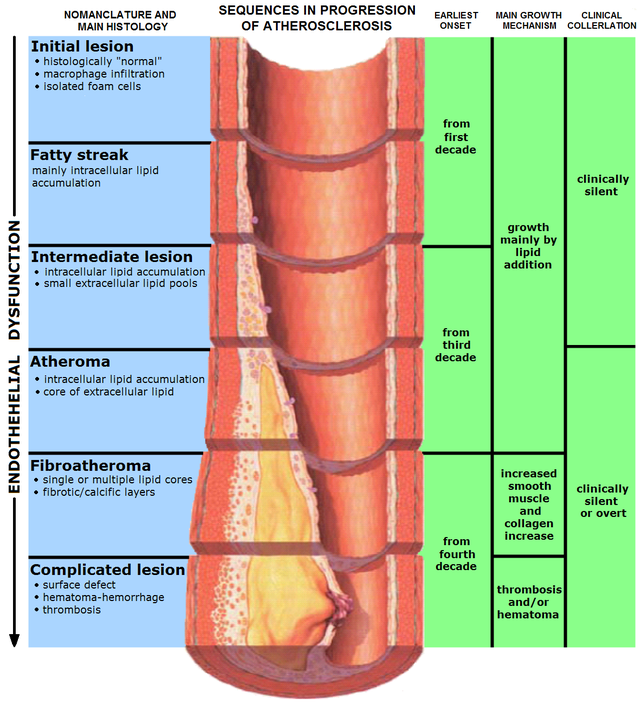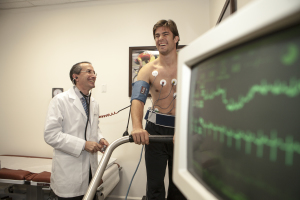What are the coronary arteries?
The coronary arteries are the blood vessels that run on the surface of the heart, bringing blood, oxygen, and nutrients to the heart muscle. As you can see on the image below, each coronary artery has a name that corresponds to its location on the surface of the heart.

Image attribution: Patrick J. Lynch, medical illustrator; adaption and further labeling: Mikael Häggström. Creative Commons Share Alike 3.0
What is coronary artery disease (CAD)?
Coronary Artery Disease (CAD) is the most common kind of heart disease and is the leading cause of death in the United States and worldwide.
CAD is a condition that usually leads to impairment or interruption of blood flow through one or more coronary arteries. As a result, heart function may be affected.
There are many different types of CAD, but by far the most common is atherosclerosis—build up of plaque—in the artery wall. Other types of CAD include congenital anomalies, inflammation of the coronary arteries, and other unusual problems.
CAD can occur at any age but is very rare in children and becomes more common in adults at progressively older ages.
The rest of this article focuses primarily on CAD due to plaques of atherosclerosis.
What is a coronary plaque and how does it build up?
A coronary artery plaque is an accumulation of material embedded inside the wall of the artery. The material commonly contains cholesterol, inflammatory cells (white blood cells), collagen, and other components, as illustrated in the image below.
The image shows the cross-section of a coronary artery and plaque. In addition, the graphic also illustrates how a plaque can develop over time. The left side shows the names given to plaques at progressive stages of development, and the right side shows roughly the time span that it takes.

Image attribution: originally from en.wikipedia, author information unknown. Permission granted under GNU free documentation license.
Note that this a simplified sketch. In reality, the course of a plaque development can vary. A plaque may grow rapidly over a matter of days or weeks, and then become stable and not change at all for years before going through another burst of development. Scientists do not yet fully understand all the factors that influence plaque development.
How can we identify plaque?
Calcium particles frequently deposit inside plaques. Because calcium is very bright when placed under x-ray, it provides a way to detect the presence of plaque by means of a CT scan of the heart, as illustrated below. The CT scan can identify plaque at a relatively early stage of development, before complications occur or before a plaque bulges into the channel of the artery to restrict the flow of blood.

Image attribution: Creative Commons 2.5 Generic License. Scheffel H, Alkadhi H, Plass A, Vachenauer R, Desbiolles L, Gaemperli O, Schepis T, Frauenfelder T, Schertler T, Husmann L, Grunenfelder J, Genoni M, Kaufmann PA, Marincek B, Leschka S. Eur Radiol. 2006 Dec; 16(12): 2739-2747.
What are the manifestations of CAD?
Coronary artery disease can manifest in a variety of ways, but in its early stages, it is always silent. At that point in time, the plaque does not block the flow of blood through the channel of the artery, so the heart muscle functions normally. This is the best time to identify the problem since no damage to the heart muscle has taken place.
Manifestations of CAD usually result when plaque build-up restricts or interrupts blood flow through the artery. The manifestations broadly fall into two categories: stable and unstable.
A typical stable CAD is a situation when plaque has built up slowly over time and is now bulging inside the blood vessel channel, causing blood flow down a coronary artery to be restricted. As a result, the heart muscle does not operate as well as it should, particularly during physical activities and exercise. A person may then feel chest tightness while walking or running. This symptom is called angina. Another person may feel short of breath, or he or she may be unable to exercise as well as before the onset of symptoms. Even at this stage, however, some people may not feel any major symptom despite the fact that blood flow is restricted.
A typical unstable CAD situation is one in which plaque builds up rapidly and blood flow to the heart muscle is acutely interrupted. A clot may be present inside the channel of the artery (see “complicated lesion” in the graphic above). The person may experience chest pain or shortness of breath with minimal activity or at rest. Other symptoms may also occur, such as nausea, or the pain may be in locations other than the chest, such as near the stomach, shoulder, back, or neck. These acute coronary syndromes are commonly called “heart attacks” (but be aware that the term “heart attack” is a loose, non medical term that may be employed in a variety of circumstances to mean different things).
An unstable CAD episode can degenerate rapidly into a very dangerous situation called sudden cardiac arrest (SCA). SCA happens when the heart rhythm is erratic and the heart is unable to pump at all. The blood pressure falls quickly and the person loses consciousness. SCA is frequently fatal unless resuscitation efforts are implemented promptly.

Erratic heart rhythm during sudden cardiac arrest. Attribution: Jason E. Roediger, GNU Free Documentation License, version 1.2 or higher.
What causes CAD?
All the factors that lead to plaque build up are not known. There is a relationship between the blood cholesterol level and plaque build up, so that the higher the blood cholesterol, the greater the chance of developing CAD. Many other factors also influence the process. People who have certain conditions such as diabetes, obesity, high blood pressure are at an increased risk for developing CAD. The two most common factors known to increase the risk of coronary disease in young adults are smoking and oral contraceptives containing synthetic estrogens.
What is the treatment for CAD?
The treatment depends on many factors, including whether CAD is causing symptoms, and whether those symptoms are stable or unstable. If CAD is detected early, one should take measures to prevent its progression. Healthy nutrition, regular exercise, and other good health habits are key, but medications may also be helpful or, in some cases, necessary.
If CAD is causing symptoms the treatment may involve medications or certain procedures such as angioplasty or surgery, depending on the severity of the problem and other factors.
Can plaque build-up be reversed?
For the most part, plaque that has built-up cannot be removed or reversed in any significant way, even with medications. Procedures such as angioplasty or bypass surgery can improve the blood flow to the heart by removing or bypassing an obstruction.
When plaque build-up is identified in its early stages, the goal is to take measures to halt the progression so that the plaques do not cause any problems. Additionally, taking measures to improve one’s health habits can improve the health of the artery, even if plaque is not removed. If progression of plaque is halted before complications occur, the prognosis is excellent.
What tests are helpful to detect CAD?
A variety of cardiac tests can give a clue to the presence of CAD or establish the diagnosis. The ECG, echocardiogram, exercise stress test are commonly used tools. A CT scan to look for calcium accumulation in the wall of the coronary arteries is a very sensitive test to detect early CAD plaques.

